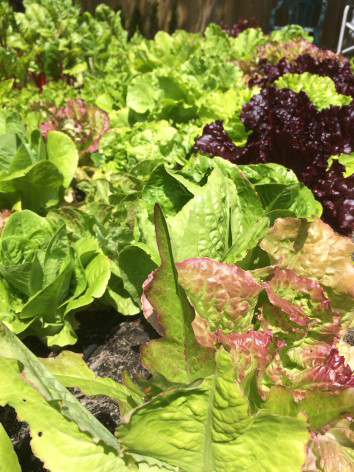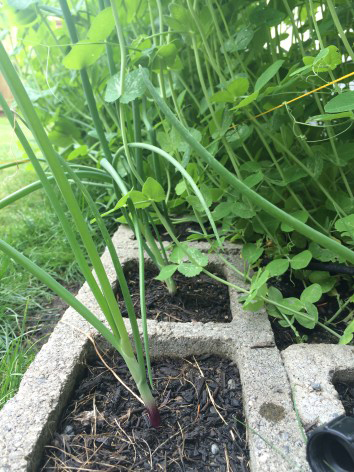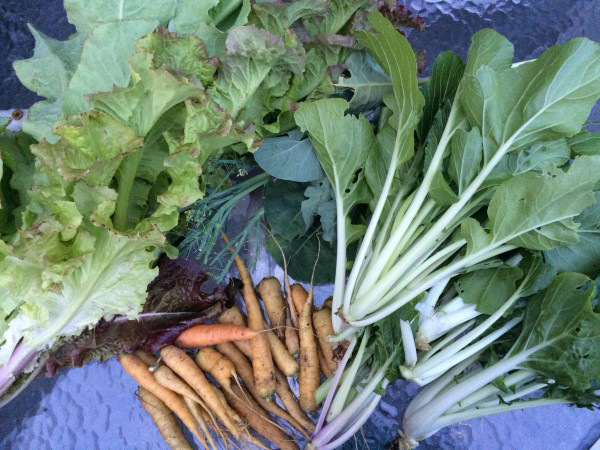Get Growing
 Last week I had a fun time blending science with nature writing about 11 healthy benefits of gardening. This week I’d like to emphasize that anyone can grow at least some of their own food, despite living circumstances. I’ve been gardening since I was a kid and throughout my years of living in homes with varying degrees of space and sunlight, I’ve found that edible plants can be grown quite literally anywhere. Growing your own food benefits your body, family, pocketbook, and home, while contributing to the overall health of the local economy and environment. “I don’t have the space” is no longer an excuse for why you aren’t producing at least some of your own food! Read on to learn 11 ways that you too can grow a garden, virtually anywhere!
Last week I had a fun time blending science with nature writing about 11 healthy benefits of gardening. This week I’d like to emphasize that anyone can grow at least some of their own food, despite living circumstances. I’ve been gardening since I was a kid and throughout my years of living in homes with varying degrees of space and sunlight, I’ve found that edible plants can be grown quite literally anywhere. Growing your own food benefits your body, family, pocketbook, and home, while contributing to the overall health of the local economy and environment. “I don’t have the space” is no longer an excuse for why you aren’t producing at least some of your own food! Read on to learn 11 ways that you too can grow a garden, virtually anywhere!
11 Tips for Growing a Garden…Anywhere!
[1] Garden in a cup.
 If you are seriously hard-pressed for space, you can grow veggies or herbs in a cup! Startagarden.org describes the best plants to grow in virtually any container, and even includes specific recommendations for growing edible foods in a plastic keg cup! Growing herbs in mason jars is one of the best ways to add flavors to your meals with minimal space or effort required.
If you are seriously hard-pressed for space, you can grow veggies or herbs in a cup! Startagarden.org describes the best plants to grow in virtually any container, and even includes specific recommendations for growing edible foods in a plastic keg cup! Growing herbs in mason jars is one of the best ways to add flavors to your meals with minimal space or effort required.
[2] Grow on-the-go, yo!
 Travel much? Just pop your keg cup garden into the cup holder of your car and take your greens to go! ;) They also make handled pots which could be tossed (carefully) into your back seat if necessary. However, if you travel away from home often, you might consider putting your outside plants on a timer with drip irrigation soaker hoses so they continue to be watered while you’re away. I did this in my garden and containers this year, and it has saved a ton of time watering! Plant Nanny is another neat tool that utilizes old wine bottles to slowly deliver water to your plants as needed. Indoor, self-watering plants and planters are another option for the frequent flyer. Or you could just grow a garden right on top of your car, so wherever you go, there it is! Where there’s a will, there’s a way…as this epic garden car demonstrates.
Travel much? Just pop your keg cup garden into the cup holder of your car and take your greens to go! ;) They also make handled pots which could be tossed (carefully) into your back seat if necessary. However, if you travel away from home often, you might consider putting your outside plants on a timer with drip irrigation soaker hoses so they continue to be watered while you’re away. I did this in my garden and containers this year, and it has saved a ton of time watering! Plant Nanny is another neat tool that utilizes old wine bottles to slowly deliver water to your plants as needed. Indoor, self-watering plants and planters are another option for the frequent flyer. Or you could just grow a garden right on top of your car, so wherever you go, there it is! Where there’s a will, there’s a way…as this epic garden car demonstrates.
[3] My-oh-microgreens and mushrooms!
 Microgreens are a fun, fast, and fancy way to grow your own nutrient-dense greens indoors, even in the cold of winter! Microgreens are plant babies eaten within days or weeks of planting their seeds, when the plants are less than 2 inches tall. You can learn to grow almost any type of seed as a microgreen such as salad greens, herbs, and tiny veggies. It’s a miniature garden that you can harvest with scissors! Microgreens can be grown year-round, indoors or outdoors, and while most thrive in the light, some varieties do just as well in lower-light situations.
Microgreens are a fun, fast, and fancy way to grow your own nutrient-dense greens indoors, even in the cold of winter! Microgreens are plant babies eaten within days or weeks of planting their seeds, when the plants are less than 2 inches tall. You can learn to grow almost any type of seed as a microgreen such as salad greens, herbs, and tiny veggies. It’s a miniature garden that you can harvest with scissors! Microgreens can be grown year-round, indoors or outdoors, and while most thrive in the light, some varieties do just as well in lower-light situations.
Mushrooms of all varieties can be grown indoors or outdoors by simply watering a bag containing their spores. It’s FUNgus for the whole family! :) They’re a great option for homes that don’t get direct sunlight, as these guys thrive in the dark. All sorts of kits and ‘mushroom farms’ containing various species can be purchased online, or even better, from your local mushroom farmers! Potatoes can also be grown in a bag.
[4] Get fresh in the kitchen.
 You can grow many different fresh and flavorful veggies and herbs right in your kitchen, including the microgreens and mushrooms mentioned above. Indoor kitchen gardening is easy to learn, fun for the whole fam, and can save you a lot of money and trips to the store for ingredients! A kitchen herb garden is probably the best bang for your buck as those herbs can be pretty pricey and sometimes hard to find! Fresh herbs are truly one of the foodie’s best friends in the kitchen, but almost all vegetables can be grown in your kitchen given the right container, soil, and proper lighting.
You can grow many different fresh and flavorful veggies and herbs right in your kitchen, including the microgreens and mushrooms mentioned above. Indoor kitchen gardening is easy to learn, fun for the whole fam, and can save you a lot of money and trips to the store for ingredients! A kitchen herb garden is probably the best bang for your buck as those herbs can be pretty pricey and sometimes hard to find! Fresh herbs are truly one of the foodie’s best friends in the kitchen, but almost all vegetables can be grown in your kitchen given the right container, soil, and proper lighting.
[5] Hang on!
 When surface area is hard to come by, or when pests or four-legged friends are acting like predators, consider hanging your plants out of harms reach! Many contraptions exist to hang your plants from a window sill, banister, railing, ceiling, or even a wall. Hanging flower baskets can beautify and colorize the outside of your home, and can also be transformed into a hanging garden by planting edible flowers, strawberries, other trailing edibles or leafy greens that are both pretty and practical.
When surface area is hard to come by, or when pests or four-legged friends are acting like predators, consider hanging your plants out of harms reach! Many contraptions exist to hang your plants from a window sill, banister, railing, ceiling, or even a wall. Hanging flower baskets can beautify and colorize the outside of your home, and can also be transformed into a hanging garden by planting edible flowers, strawberries, other trailing edibles or leafy greens that are both pretty and practical.
[6] Contain(er) yourself!
 You might be surprised to learn that you can grow almost any veggie, herb, or fruit when it’s planted in the right container! If you’ve got any amount of free space on your porch, balcony, window sill, countertop, fire escape or anywhere else that receives sunlight, you can grow at least some of your own food at home. Pots, boxes, buckets, furniture and containers of all sorts can be used to grow edible plants in. Check out startagarden.org to learn what plants grow well in the containers you already have!
You might be surprised to learn that you can grow almost any veggie, herb, or fruit when it’s planted in the right container! If you’ve got any amount of free space on your porch, balcony, window sill, countertop, fire escape or anywhere else that receives sunlight, you can grow at least some of your own food at home. Pots, boxes, buckets, furniture and containers of all sorts can be used to grow edible plants in. Check out startagarden.org to learn what plants grow well in the containers you already have!
[7] Grow up!
Vertical Gardening is the concept of growing ‘up’ rather than ‘out’. If you’re lacking surface area in your life, or don’t have a yard, then vertical gardening might be just the thing for you! There’s many ways to utilize the often wasted space above and around us using stacking planters, ceiling hangers, simple wall hangers, bookshelf style planters, or if you’re feeling fancy, you can even turn an entire wall or fence into an explosive garden!
[8] Raise the (green) roof!
 A green roof (AKA living roof) refers to growing plants on the roof of a building. The practice of cultivating food on roofs (rooftop farming) comes with a number of environmentally-friendly benefits. Most common in urban environments, rooftop gardens can be accomplished by growing plants in containers that are kept on the roof. However a true rooftop garden utilizes the roof as the land, and plants grow directly out of the rooftop (make sure to get the okay from your landlord before trying this at home folks)! ;)
A green roof (AKA living roof) refers to growing plants on the roof of a building. The practice of cultivating food on roofs (rooftop farming) comes with a number of environmentally-friendly benefits. Most common in urban environments, rooftop gardens can be accomplished by growing plants in containers that are kept on the roof. However a true rooftop garden utilizes the roof as the land, and plants grow directly out of the rooftop (make sure to get the okay from your landlord before trying this at home folks)! ;)
[9] Sharing is caring.
Many cities and towns have community  garden programs where you can lease land for a nominal fee and grow to your hearts content! Community gardens are a great way to meet new people, learn gardening skills and contribute to the health of your land. Trade with your plot neighbors or agree to grow different veggies to double your diversity. It also doesn’t hurt to have other people helping to watch over and water your plants when you’re away!
garden programs where you can lease land for a nominal fee and grow to your hearts content! Community gardens are a great way to meet new people, learn gardening skills and contribute to the health of your land. Trade with your plot neighbors or agree to grow different veggies to double your diversity. It also doesn’t hurt to have other people helping to watch over and water your plants when you’re away!
[10] Live long and forage on!
 Gathering wild edible plants from urban environments is the way of the day for the modern Paleo gatherer. A friend of mine, Philip Stark, was recently interviewed by the New York Times about his expertise of urban foraging. Philip is the principle investigator at the Berkeley Open Source Food project where his team studies urban foraging as a means of “increasing the supply of fresh, affordable, nutritious, drought-resistant, low-carbon-impact greens, especially in urban food deserts.” Philip’s research and lifestyle exemplify how easy it is to forage edible organic greenery from virtually any temperate urban environment, most days of the year!
Gathering wild edible plants from urban environments is the way of the day for the modern Paleo gatherer. A friend of mine, Philip Stark, was recently interviewed by the New York Times about his expertise of urban foraging. Philip is the principle investigator at the Berkeley Open Source Food project where his team studies urban foraging as a means of “increasing the supply of fresh, affordable, nutritious, drought-resistant, low-carbon-impact greens, especially in urban food deserts.” Philip’s research and lifestyle exemplify how easy it is to forage edible organic greenery from virtually any temperate urban environment, most days of the year!
[11] You’ve made your bed, now lay (plants) in it!
 I’m pretty excited this growing season because it’s the first year I’ve ever lived in a place where I could finally build raised beds to grow my organic vegetables in! I went a little hog wild and built seven booming garden beds (see pics below), and I’ve been having a heck of a time trying to keep up with this summer’s bounty!
I’m pretty excited this growing season because it’s the first year I’ve ever lived in a place where I could finally build raised beds to grow my organic vegetables in! I went a little hog wild and built seven booming garden beds (see pics below), and I’ve been having a heck of a time trying to keep up with this summer’s bounty!

I make my own organic potting soil (since many commercial soils contain questionable ingredients such as perlite , vermiculite and peat moss) by mixing quality local soil + homemade compost + an aerating agent, like coconut coir. I collect my veggie scraps in a kitchen composter and toss them (along with yard scraps) into an outdoor composting bin, which transforms the scraps into organic compost within weeks! I always make sure to use only certified organic and non-genetically modified (non-GMO) seeds from sustainable companies, like Seeds of Change.
Grow on Paleo

Once you get past any initial learning curves, it’s easy as Paleo pie to grow a garden just about anywhere. I would say it’s ‘extremely Paleo’ of you to grow your own food, but considering that cavemen weren’t cultivating, they were gathering on-the-go, I suppose gardening isn’t ‘Paleo’ per se. Nonetheless, growing your own food is still totally rad (yep, RAD!) and just about anyone can do it with very few resources invested. There’s something extremely primal and truly fulfilling about eating food that you’ve grown all by yourself…it just feels right as daylight! If you fancy yourself a hard-core Paleoite, foodie, or an environmentalist, then it’s time to bury the excuses and get growing!
In good health,
Kinsey Jackson, LMP, MS, CNS®














